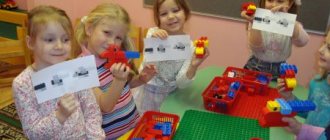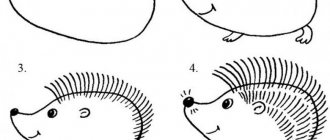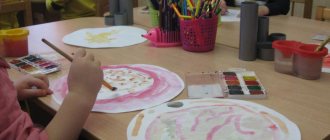Middle group. Junior preschool age. Children 4 - 5 years old
General conversation for children of the middle group “How forest animals spend the winter in the forest” Objectives: to promote the formation of generalized ideas that different animals live in the forest, that winter is a difficult time of year for everyone, that animals are differently adapted to life at this time year; to form an idea of the role of man in the life of animals in the forest in winter...
Conversation in the middle group “Vegetables and fruits are healthy foods”
Goal: Systematize and expand knowledge about vegetables and fruits, their diversity; introduce children to vitamins and reveal their importance for human health; Progress of the lesson: The teacher greets the children and says: “Now the one who repeats after me will sit down. Tomato, beet,...
High school didactics
Lesson-conversation. In the form of a conversation, it is useful to conduct a survey and explain new material at the first stage of training. A characteristic feature of this form of lesson is that students take an active part in it - answer questions, draw independent conclusions from demonstration experiments, and explain phenomena. All this, of course, is corrected by the teacher, he guides such a conversation, clarifies and finally formulates the answers.
At the beginning of the lesson, it is advisable to conduct a review in the form of a conversation in order to test the students’ knowledge and restore the picture of the material covered in order to move on to subsequent questions.
Then it is useful to identify examples from the life experience of students related to the issue under study (for example, before introducing the concept of Archimedean force - phenomena they noticed while swimming), ask students to try to explain these phenomena, thereby showing them the need to gain new knowledge (problem situation) .
Then you should move on to demonstration or independent experiments, the explanation of which must first be given to students. In this case, it is better to call students to answer by name, otherwise only a few students will be actively working. The teacher first asks a question, gives time to think, and then says the student's name. (It is useful to have a special notebook with a class list and record all the answers in it; for such 2-3 answers you need to put a grade in the journal. You can also evaluate a student’s question if it reveals knowledge.) First of all, it is recommended to call a weak student (but not too weak). drag out the conversation). If he answers incorrectly, then ask him to listen carefully to the other answers, warn that after finding out the correct answer he will have to repeat it. After the answer is found and finally corrected by the teacher, such a repetition should be carried out.
To successfully conduct a conversation lesson, it is important that the teacher establishes good contact with the class, observes them and achieves a complete understanding of the issue being studied in the lesson.
A conversation lesson is one of the most difficult forms of a lesson. It requires the teacher to have good professional training. You need to carefully select questions and anticipate possible answers to them. The conversation should be lively and relaxed, only then will it capture all the students in the class and give the desired effect.
And at the first stage of training, part of the lesson can be occupied by a long, coherent story from the teacher. It is inevitable in the case when the student does not have data for independent conclusions or descriptions of the phenomenon, for example, when presenting the basic principles of molecular kinetic or electronic theory; it is necessary when presenting historical information and technical applications of physics.
Lesson-lecture. This form of lesson is recommended for use at the second stage of teaching physics, increasing its place in the educational process by the graduating class; it represents a continuous presentation by the teacher of the content of the topic associated with demonstration experiments. As already said, this form is inevitable in some cases, depending on the content of the lesson. It has its advantages, for example, it allows you to save time spent on explaining the material.
The importance of lectures in high school is that students gradually prepare for listening to lectures in further education. It is recommended to teach students to take notes on lectures and make plans.
The great advantage of lectures is the opportunity to show a logical, coherent structure of a train of thought, to teach students to correctly and convincingly present the content of physical material, since natural science disciplines require certain thinking, certain evidence. During the lecture presentation of the material, the above diagram can be clearly shown: facts - hypothesis - experimental evidence - practical applications. Students see how to justify their judgments, formulate a conclusion, briefly, accurately and clearly express thoughts, etc.
A carefully designed and prepared lecture, accompanied by good demonstrations and interesting examples, can serve as a model; even without special techniques, it activates the thinking and attention of students, and makes an impression on them.
A lesson-lecture, like any lesson, is usually accompanied by a survey, reinforcement of the material, independent work can also be carried out for part of the lesson, however, pure lesson-lectures, including two-hour ones, are currently practiced in a number of schools for listening to lectures in the classroom combine several classes. However, we note that even in the graduating class, it is advisable to conduct some lessons in the form of a conversation.
Independent work of students.
The scientific and methodological ideas of the modern physics course dictate the need to increase attention to the independent work of students, especially to work aimed at independently acquiring and replenishing knowledge. If earlier the main goal of independent work was to consolidate and repeat knowledge, now, in connection with the generalization of educational material, such an area of independent work as students themselves studying particular facts, applications of physics in technology and everyday life based on knowledge of the basic principles of science has developed. its laws and theories, more general concepts. For example, in the VI grade course, the textbook previously described in detail such applications of communicating vessels as water pipes, sluices; Now students are asked to explain these applications independently using the drawing given in the textbook. As mentioned above, work on independent acquisition of knowledge from textbooks and laboratory classes has been strengthened.
When organizing this work, the teacher should keep in mind that it is not advisable to trust students to study every topic of the course on their own. The complexity of the questions, their significance, and the presence of prior knowledge are taken into account. For example, the topic “Archimedean force” (VIth grade) is not suitable for independent study, since this concept is introduced on the basis of rather complex demonstration experiments and no less complex explanations, and if you entrust its study to students, you will have to re-explain it to those from them who cannot learn it on their own. On the contrary, the topic “Floating Bodies”, related to the concept of Archimedean force, fits well with the requirements of independent study: it outlines the application of a more general previous concept to practice, conclusions are drawn on the basis of a simple experiment that it is advisable for students to carry out themselves; Possible student errors are relatively easily eliminated.
Let's consider the main types of independent work, students, pay attention to independent replenishment of knowledge.
a) Laboratory work and frontal laboratory experiments.
The methods and techniques for conducting front-line laboratory work and workshop work are described in special manuals for teachers. Work is carried out before the introduction of a new concept, to consolidate the introduced concept, determine the meaning of its value, introduce or verify the law. It is recommended, for example, to study the structure of a dynamometer during frontal work, and the structure of an ammeter, voltmeter, rheostat and other instruments - with the help of frontal experience.
There is also a practice of carrying out work when specific values are introduced after they are determined in laboratory work. For example, students determine the mass and volume of a body, and then, according to the teacher’s instructions, calculate the mass of a unit volume of the body, after which the teacher explains that this quantity is called density, talks about its meaning, and then studies it as usual.
A system for introducing concepts based on independent experimentation is presented in the articles of V. A. Burov.
It is difficult for a teacher to evaluate the performance of laboratory work. It is hardly possible to give a reliable assessment to each student, because you need to evaluate mainly the practical part of the work, and not its design. To properly evaluate work, we can recommend the following technique: the teacher selects several students for observations (their number is determined by the teacher himself) and records for himself (it is convenient to do this in a special notebook and using a short note or special signs) the quality of their work. You should evaluate the handling of instruments, accuracy of execution, degree of activity, understanding of tasks and progress of work (for this you can approach the students and ask questions), etc. At the end of the lesson, the teacher calls the names of these students so that they give him a description of their work. When checking a notebook, you should provide a justification for the assessment, taking into account the observations made in the lesson and the quality of the description. When carrying out the next work, another group of students is assessed; two or three students may enter it again, so that diligence is shown each time. This technique makes the assessment of work more reliable and increases the student’s responsibility for its implementation. The authority of laboratory work also increases, as students are convinced that the grade is not given formally.
When assessing work in this way, it should, of course, be allowed that for each work, grades are given in the journal not to the whole class, but selectively. The teacher is also given the right to vary the content of the work, provided that no fundamental changes are made to them: to combine or, conversely, to divide the work into parts depending on the method of conducting the lesson. Some teachers, for example, combine work on the study of permanent magnets (grade VII), but conduct the study of parallel connections in parts.
b) Problem solving.
Along with the communication of new knowledge, the methodology of teaching physics devotes a large place to its consolidation and use, in particular, problem solving. Without the use of this method it is impossible to imagine teaching physics. Note that in pre-revolutionary Russian secondary schools this method was almost not used and when passing the matriculation exam, applicants did not solve problems in physics. This method was created and developed in Soviet secondary schools. Currently, its importance has increased in connection with the task of developing students’ thinking.
. In relation to the first stage of teaching physics, when the student is just beginning to comprehend the fundamentals of this science, when he needs to instill interest in it, show its specific methods, etc., it is especially important that this teaching method - problem solving - take a certain place and did not supplant other methods. Thus, teaching experience shows that the number of problems contained in the textbook of grades VI-VII is sufficient to provide such aspects of the educational process as consolidation of material, training in solving problems, monitoring students’ knowledge and selecting problems for students with different academic performance.
When solving problems, one should use one of the most powerful incentives in teaching children of this age—cognitive interest. To do this, you need to select problems with interesting content, an interesting result for students (for example, determining the pressure exerted by a student on the floor, etc.) or make the design of the conditions and solution of the problem interesting (instead of the usual problem from a problem book on determining the speed of a body, solve an experimental problem - Determine the speed of a wind-up toy car by measuring the distance it travels through the class and the time it takes). Problems with historical content not only create interest, but also introduce students to the history of physics without spending additional time.
For students in grades VI and VII, problems related to the analysis of drawings are interesting. The figure may depict a phenomenon or indicate some data, show a scale and instrument readings, etc. The student is asked to explain the drawing or supplement it, determine the division value or instrument readings, draw a diagram based on the drawing, etc. Solutions to such problems are completed quickly , their correctness can be easily checked by looking at the pictures; you can give marks for the solutions.
The most effective ones include experimental problems, the solution of which is associated with observation or experience. To perform them, you can use office equipment and various available tools. For example, the transfer of pressure by a liquid can be observed using a plastic bottle of liquid soap, puncturing holes in it; study the swimming of bodies with glass pill bottles, attaching a wire hook, etc. to the plastic lid.
Combined problems are also useful, in which students first theoretically determine the desired quantity and then check the result of the calculation experimentally, for example, finding out whether a given solid body will float in water (or other liquid). To solve the problem, you need to determine the density of the body, compare it with the density of water, draw a conclusion and test it experimentally.
Teaching experience shows that at the first stage of teaching physics, students find it difficult to calculate problems with only three steps and problems that require mathematical transformations. For example, they determine density and mass relatively easily, but find it difficult to find the volume of a body. Therefore, when selecting calculation (quantitative) problems, it is necessary to take into account that direct tasks are available to each student, to determine the main quantity and problems in one or two steps.
At the first stage of teaching physics, qualitative problems are especially useful. But the answers to... Qualitative problems are not always unambiguous, so it is useful to discuss such problems in class and, together with students, clarify the answers and the course of reasoning.
At the second stage of physics training, the criteria for selecting problems change. As training exercises, you should use not only tasks in one or two steps, but also more complex ones; more attention should be paid to tasks that use knowledge of several sections and topics of the course. The requirements for the design of problem solving also differ.
In the practice of teaching physics, techniques for recording and solving problems have been developed. Before solving the problem, you must carefully read and write down its conditions; Usually the entry is made in the left corner of the notebook (or board), with the values denoted by letters, and the numerical values are accompanied by the recording of units of measurement, both of which must comply with GOST.
If you find an error, please select a piece of text and press Ctrl+Enter.
Pages: 1






